Israel Bombs Damascus: What’s Behind the Escalation? Syriana Analysis
Kevork Almassian talks to Sarkis Yousef about the War Clouds Over Damascus, Israeli Airstrikes, and the Continued Attacks Against the Syrian Minorities
Kevork Almassian talks to Sarkis Yousef about the War Clouds Over Damascus, Israeli Airstrikes, and the Continued Attacks Against the Syrian Minorities
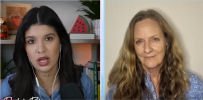 Independent Journalist Vanessa Beeley, who was based in Damascus up until the Al Nusra coup on 8 December 2024, discusses her evacuation from Syria, and what the end of the Assad Government means for the Syrian people and the future of foreign interference in the country. She also discusses the extreme suddenness of the coup and Russia's about-face, which seemed to lead so unexpectedly to Bashar al-Assad's very uncharacteristic resignation from his presidency.
Independent Journalist Vanessa Beeley, who was based in Damascus up until the Al Nusra coup on 8 December 2024, discusses her evacuation from Syria, and what the end of the Assad Government means for the Syrian people and the future of foreign interference in the country. She also discusses the extreme suddenness of the coup and Russia's about-face, which seemed to lead so unexpectedly to Bashar al-Assad's very uncharacteristic resignation from his presidency.
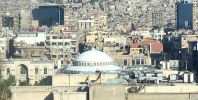 The writer of this article has returned home to Syria, after emigrating to a western country years ago. He reports on his arrival in Damascus, the capital of Syria, which is where much of the population has taken shelter from the activities of western backed 'rebels'. He last visited Aleppo in Syria between 2015-2016, for 9 months, shortly before the Syrian Arab Army, with the help of the Russians, managed to drive out ISIS. Photo was taken by the author on his current visit. (We split it up into smaller images due to size of initial image.)
The writer of this article has returned home to Syria, after emigrating to a western country years ago. He reports on his arrival in Damascus, the capital of Syria, which is where much of the population has taken shelter from the activities of western backed 'rebels'. He last visited Aleppo in Syria between 2015-2016, for 9 months, shortly before the Syrian Arab Army, with the help of the Russians, managed to drive out ISIS. Photo was taken by the author on his current visit. (We split it up into smaller images due to size of initial image.)
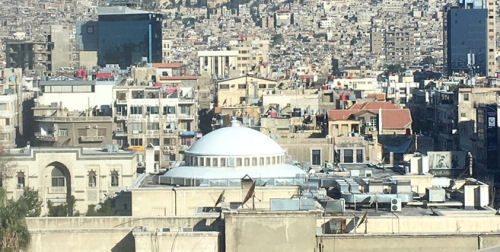
I’m in Damascus right now. I arrived yesterday to the capital with one of my uncles.
The msm propaganda is a nasty one.
As in the city, I’m feeling very safe, although it’s so crowded and with a lot of traffic jams. Flying jets’ sounds in the sky from time to time.
As for the daily random shells from the terrorists in East Ghouta upon the heads of civilians in Damascus city, and mostly on Old Damascus, where the ancient churches and mosques are located, almost no corporate msm is covering it or really cares about the lives of those civilians. This is the same double standard that had been used in East Alepppo in Dec 2016.
As for the people in E. Ghouta, the same scenario of East Aleppo had been followed by the terrorists, which is to prevent the people from leaving Ghouta to the government-held areas through the humanitarian corridors, and to take them as human-shields, and whoever tries to flee Ghouta is shot by snipers from the terrorists. The msm reporters are claiming that people don’t want to leave! Lies and nothing but lies!
Check out this report for good information: https://www.rt.com/newsline/421461-ghouta-evacuation-aid-ceasefire/
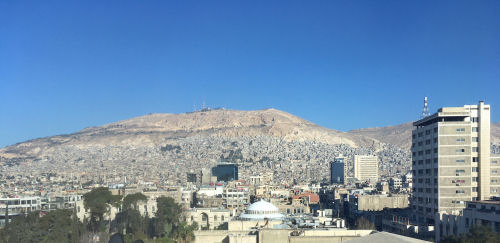
On yesterday’s local news, thousands of kidnapped civilians left to government-held areas, in a deal with the terrorists, or after the liberation of one chunk of the Ghouta. I didn’t read the full news but just a brief ones about what happened yesterday. The people gave different witness from the ones on the msm. They were relieved and happy to flee that war zone.
People of Damascus want that daily nightmare to end for good. The only way is by the surrendering of those terrorists and to leave Ghouta and go to Idlib, as they did everywhere before, and to help people go back to their homes and to have all necessary services for life (food, water, etc) which the terrorists are preventing the people of Ghouta from having.
Another play and fabricated clips are going on by the White Helmets (in both Ghouta and Idleb) to show a chemical attack and blame it on the government, to give an excuse for the US and it’s allies to strike Syrian forces. Russia gave a warning of such a scenario and that they will fight back if the west continued that silly play and provocation.
I’m staying for 3 days or so in Damascus to see some friends in a hotel, although we have a house, but it’s occupied by a far relatives to our relatives who are from East Ghouta but had left it few years ago to stay in the government-held areas and in our house - another evidence that people are against those terrorists who occupied their territories. The last time I visited Damascus was 12 years ago (Summer 2006, at the time of July War).
It’s the (copy-paste) scenario of East Aleppo all over again. Same lies, same propaganda, same UN hysteria , and it will hopefully end the same way by victory to the people and government against the terrorists.
 There is a humanitarian catastrophe unfolding in Syria and the "western" media ignore it. On December 22 al-Qaeda aligned Takfiris in the Wadi Barada valley shut down the main water supply for the Syrian capital Damascus. Since then the city and some 5-6 million living in and around it have to survive on emergency water distributions by the Syrian government. That is barely enough for people to drink - no washing, no showers and no water dependent production is possible. Article originally published at Moon of Alabama. Sources of pictures and enlargements also available there.
There is a humanitarian catastrophe unfolding in Syria and the "western" media ignore it. On December 22 al-Qaeda aligned Takfiris in the Wadi Barada valley shut down the main water supply for the Syrian capital Damascus. Since then the city and some 5-6 million living in and around it have to survive on emergency water distributions by the Syrian government. That is barely enough for people to drink - no washing, no showers and no water dependent production is possible. Article originally published at Moon of Alabama. Sources of pictures and enlargements also available there.
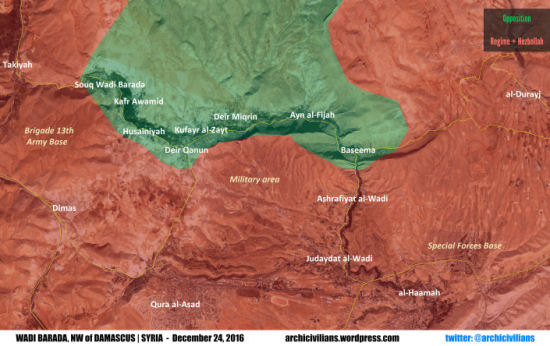 This shut down is part of a wider, seemingly coordinated strategy to deprive all government held areas of utility supplies. Two days ago the Islamic State shut down a major water intake for Aleppo from the Euphrates. High voltage electricity masts on lines feeding Damascus have been destroyed and repair teams, unlike before, denied access. Gas supplies to parts of Damascus are also cut. A similar tactic was used by the Zionist terrorists of the Haganah who in 1947/48 poisoned and blew up the water mains and oil pipelines to Palestinian Haifa.
This shut down is part of a wider, seemingly coordinated strategy to deprive all government held areas of utility supplies. Two days ago the Islamic State shut down a major water intake for Aleppo from the Euphrates. High voltage electricity masts on lines feeding Damascus have been destroyed and repair teams, unlike before, denied access. Gas supplies to parts of Damascus are also cut. A similar tactic was used by the Zionist terrorists of the Haganah who in 1947/48 poisoned and blew up the water mains and oil pipelines to Palestinian Haifa.
Wadi Barada is a river valley some 10 miles west of Damascus at the mountain range between Lebanon and Syria. It has been in the hands of local insurgents since 2012. The area was since loosely surrounded by Syrian government forces and their allies from Hizbullah.
Two springs in the area provide the water for Damascus which is treated locally and then pumped through pipelines into the city's distribution network. Since the early 1990s there is a low level conflict over the water diversion of the Barada river valley to the ever growing Damascus. The drought over the last years has intensified the problems. Local agriculture of the water rich valley had to cut back for lack of water as this was pumped into the city. But many families from the valley moved themselves into the city or have relatives living there.
The local rebels had kept the water running for the city. Al-Qaeda aligned groups have been in the area for some time. A propaganda video distributed by them and taken in the area showed (pic) the choreographed mass execution of Syrian government soldiers.
After the eastern part of the city of Aleppo was liberated by Syrian government forces, the local rebels and inhabitants in the Barada river valley were willing to reconcile with the Syrian government. But the al-Qaeda Takfiris disagreed and took over. The area is since under full al-Qaeda control and thereby outside of the recent ceasefire agreement.
On December 22 the water supply to Damascus was suddenly contaminated with diesel fuel and no longer consumable. A day later Syrian government forces started an operation to regain the area and to reconstitute the water supplies.
Photos and a video on social media (since inaccessible but I saw them when they appeared) showed the water treatment facility rigged with explosives. On Dec 27th the facility was blown up and partly destroyed.
Suddenly new organized "civil" media operations of, allegedly, locals in the area spread misinformation to "western" media. "There are 100,000 civilians under siege in Wadi Barada!" In reality the whole area once had, according to the last peacetime census, some 20,000 inhabitants. The White Helmets propaganda organization now also claims to be in the area. "The government had bombed the water treatment facility," the propaganda groups claimed.
That is a. not plausible and b. inconsistent with the pictures of the destroyed facility. These show a collapse of the main support booms of the roof but no shrapnel impact at all. A bomb breaking through the roof and exploding would surely have left pocket marks all over the place. The damage, in my judgement, occurred from well designed, controlled explosions inside the facility.
Some insurgents posted pictures of themselves proudly standing within the destroyed facility and making victory signs.
There is more such cheer-leading by insurgents on social media. Why when they claim that the government bombed the place?
On December 29 the UN Office for the Coordination of Humanitarian Affairs issued an alarm about the water crisis:
The United Nations is alarmed that four million inhabitants in Damascus and surrounding areas have been cut off from the main water supply since 22 December. Two primary sources of drinking water- Wadi Barada and Ain-el-Fijah-which provide clean and safe water for 70 percent of the population in and around Damascus are not functioning, due to deliberate targeting resulting in the damaged infrastructure.
One of the two springs, Al-Feejeh, has now been retaken by the Syrian army. 1,300 civilians from Ain AlFeejeh, the nearby town with the treatment facility, have fled to the government held areas and were taken in by the Syrian Red Cross. The other spring and the treatment facility are still in Takfiri hands. The government has said that it will need some ten days to repair the system after the Syrian army has gained control of the facilities. That will still take some time.
Western media have hardly taken notice of the water crisis in Damascus and their coverage seems to actively avoid it. A search for Barada on the Washington Post website brings up one original piece from December 30 about the freshly negotiated ceasefire. The 6th paragraph says:
Airstrikes pounded opposition-held villages and towns in the strategically-important Barada Valley outside Damascus, activists said, prompting rebels to threaten to withdraw their compliance with a nationwide truce brokered by Russia and Turkey last week.
Then follow 16 paragraphs on other issues. Only at the very end of the piece comes this (mis-)information:
The Barada Valley is the primary source of water for the capital and its surrounding region. The government assault has coincided with a severe water shortage in Damascus since Dec. 22. Images from the valley’s Media Center indicate its Ain al-Fijeh spring and water processing facility have been destroyed in airstrikes. The government says rebels spoiled the water source with diesel fuel, forcing it to cut supplies to the capital.
On December 29 a piece by main WaPo anti-Syria propagandist Liz Sly did not mention the water crisis or the Barada valley at all.
The New York Times links a Reuters pieces about the UN alarm about the water crisis. But I find nothing in its own reporting that even mentions the water crisis. One piece on December 31 refers shortly to attacks on Wadi Baradi by government forces at its very end.
A Guardian search for Barada only comes up with a piece from today mixed from agency reports. The headlines say "Hundreds of Syrians flee as Assad's forces bomb Barada valley rebels". The piece itself says that they flee to the government side. In it the Syrian Observatory (MI-6) operation in Britain confirms that al-Qaeda rules the area which "Civil society organisations on the ground" deny. Only the very last of the 12 paragraph piece mentions the capital:
The Barada valley is the primary source of water for the capital and its surrounding region. The government assault has coincided with a severe water shortage in Damascus since 22 December. The government says rebels spoiled the water source with diesel fuel, forcing it to cut supplies to the capital.
Surely a few people "fleeing" (to the government side) "as Assad's forces bombs" are way more important than 5 million people in Damascus without access to water. That the treatment facility is destroyed seems also unimportant.
All the above papers have been extremely concerned about every scratch to any propaganda pimp who had claimed to be in then rebel held east-Aleppo. They now show no concern at all for 5 million Syrians in Damascus who have been without water for 10 days and will likely be so for the rest of the month.
Posted by b on January 2, 2017 at 02:42 PM | Permalink
 Published on Dec 13, 2016, "Syriennes" - "Syrians" is a beautiful documentary made in Syria by Julien Rochedy for TV Libertés, about how Syrian girls and women feel about the prospect of a 'rebel' win. It includes an interview with an Australian-Syrian woman who returned to Syria when the war began. Girls in Damascus and the regions not controlled by the US-NATO-backed rebels are currently free to study, to follow their passions and to exercise their professions, but they live in fear of a 'rebel' win in the Syrian conflict. We see how many women in Damascus wear western clothes and bare heads, walk freely down the street and eat in cafes alone, just like girls in Sydney or Brisbane. The film also interviews women in Damascus who have escaped the 'Free Syrian Army', Daesh/ISIS and Al Nusra. Their tales are chilling. It is obvious that no woman could benefit from a victory by the militia that the US and NATO support. Women are 50% of Syria's population, so why does Australia and the US NATO support the 'rebels', who are all 'takfiris', that is, Islamic fundamentalists? And what excuse does the west have for the crippling and illegal sanctions imposed on Syria for decades now. It is pointed out that Iraq was subject to similar sanctions for ten years before the US invasion, and that tens of thousands of children died because of this. This film about the most bloody conflict of the early 21st century permits us to understand a much more complex reality than the mainstream media paints.
Published on Dec 13, 2016, "Syriennes" - "Syrians" is a beautiful documentary made in Syria by Julien Rochedy for TV Libertés, about how Syrian girls and women feel about the prospect of a 'rebel' win. It includes an interview with an Australian-Syrian woman who returned to Syria when the war began. Girls in Damascus and the regions not controlled by the US-NATO-backed rebels are currently free to study, to follow their passions and to exercise their professions, but they live in fear of a 'rebel' win in the Syrian conflict. We see how many women in Damascus wear western clothes and bare heads, walk freely down the street and eat in cafes alone, just like girls in Sydney or Brisbane. The film also interviews women in Damascus who have escaped the 'Free Syrian Army', Daesh/ISIS and Al Nusra. Their tales are chilling. It is obvious that no woman could benefit from a victory by the militia that the US and NATO support. Women are 50% of Syria's population, so why does Australia and the US NATO support the 'rebels', who are all 'takfiris', that is, Islamic fundamentalists? And what excuse does the west have for the crippling and illegal sanctions imposed on Syria for decades now. It is pointed out that Iraq was subject to similar sanctions for ten years before the US invasion, and that tens of thousands of children died because of this. This film about the most bloody conflict of the early 21st century permits us to understand a much more complex reality than the mainstream media paints.
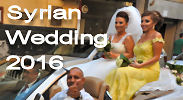 This is a photo-essay by Eva Bartlett about life in Damascus, the capital city of Syria, today. Some might find it surprising to see that people still walk the streets, smile and dance in discos, that many women go bare-headed and bare-armed. This looks like any European or Australian city. Yes, there is a war on and foreign-backed forces seem determined to destroy Syria, but they have not succeeded yet. There is obviously so much to Syria, so many layers, so many strengths, that contradict the two-dimensional impression conveyed by Australian and other western mass-media. This false impression has been assisted by Soros-financed 'Aid' groups and others who have remarketed Syria as a mere a basket-case of refugees, with no acknowledgement of the Syrian government's successful efforts to protect its people, resettle refugees, and fight back against foreign-backed terrorists. To see this photo-essay is to suddenly realise that Syria is just waiting to spring back to life. Emboldened words have been added to highlight photo-relationship to text. Editor, Candobetter.net
This is a photo-essay by Eva Bartlett about life in Damascus, the capital city of Syria, today. Some might find it surprising to see that people still walk the streets, smile and dance in discos, that many women go bare-headed and bare-armed. This looks like any European or Australian city. Yes, there is a war on and foreign-backed forces seem determined to destroy Syria, but they have not succeeded yet. There is obviously so much to Syria, so many layers, so many strengths, that contradict the two-dimensional impression conveyed by Australian and other western mass-media. This false impression has been assisted by Soros-financed 'Aid' groups and others who have remarketed Syria as a mere a basket-case of refugees, with no acknowledgement of the Syrian government's successful efforts to protect its people, resettle refugees, and fight back against foreign-backed terrorists. To see this photo-essay is to suddenly realise that Syria is just waiting to spring back to life. Emboldened words have been added to highlight photo-relationship to text. Editor, Candobetter.net
Life for many in Damascus, Syria is beginning to regain a sense of normalcy. Once besieged by foreign fighters, the ancient city and it's residents struggle to rebuild their lives, land and livelihood, rejoicing in the simple mundanity of day-to-day life.
The croissant stand in Aamarie district of Thomas Gate is known not only to Damascenes but visitors from other areas of Syria. While prices for most goods have risen all across Syria, the stand keeps its prices low: 125 Syrian pounds per sumptuous croissant. On the first day of ‘Eid celebrations the stand is packed.
Damascus — On prior visits to Damascus, staying in the Old City, the sound of mortars being fired from terrorist-held districts outside of the city was a constant. In recent months, the mortars on Damascus have stopped. Previously, Jebhat al-Nusra (Al Qaeda in Syria), Jaysh al-Islam and the Free Syrian Army, among other terrorist factions, rained mortars daily on residential areas of Damascus, hitting schools, homes, vehicles and pedestrians, killing and maiming indiscriminately, leaving civilians, including children, with critical injuries and amputations.
With the recent absence of mortars, Damascenes have opened outdoor establishments where before it was formerly too dangerous. Sidewalks cafes and outdoor eateries open at night were unthinkable less than half a year ago, let alone rooftop cafes and lounges. Although Syrians suffer immensely from an economy devastated by war and western sanctions, in Damascus there is a renewed sense of defiance, a refusal to give in, or as a young man in his twenties visiting from Aleppo said: “They have their own war against death by living.”
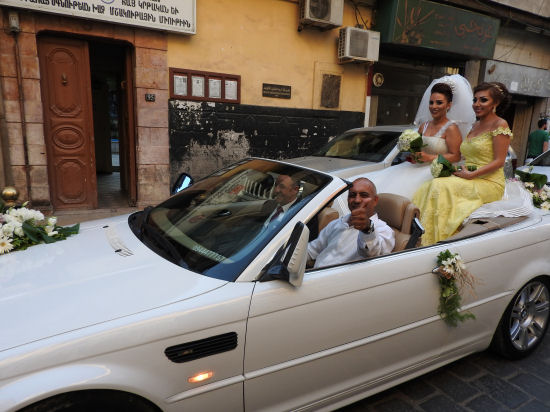
Wedding procession in the Old City of Damascus. Love and life continue. A newcomer to Syria might be surprised by the vibrancy of life among Damascus residents, who have lived under al-Nusra and Jaysh al-Islam mortars for years, as well as cruel sanctions. “Tawadna” is a phrase that is heard often in Syria: “We got used to it.” Even when mortars rained down, Syrians celebrated their weddings and festivals. Now, in Damascus at least, it is safer to do so outside.Wedding procession in the Old City of Damascus. Love and life continue. A newcomer to Syria might be surprised by the vibrancy of life among Damascus residents, who have lived under al-Nusra and Jaysh al-Islam mortars for years, as well as cruel sanctions. “Tawadna” is a phrase that is heard often in Syria: “We got used to it.” Even when mortars rained down, Syrians celebrated their weddings and festivals. Now, in Damascus at least, it is safer to do so outside.
The book market near the President's Bridge and Damascus University is an institution in Damascus, known to book lovers who can't afford bookstores. It is one Damascus venue which refused to shut down over the years, mortars or not. In addition to its Arabic books, one can find English language books and cookbooks, English literature, popular English-language thrillers and taudry romance novels. The book market near the President’s Bridge and Damascus Univeristy is an institution in Damascus, known to book lovers who can’t afford bookstores. It is one Damascus venue which refused to shut down over the years, mortars or not. In addition to its Arabic books, one can find English language books and cookbooks, English literature, popular English-language thrillers and taudry romance novels.
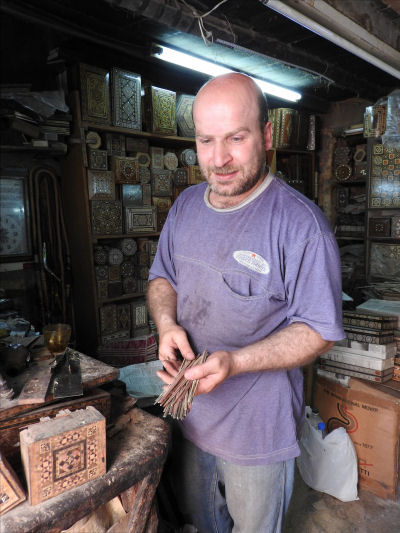
In the narrow lanes of Old Damascus, a wooden mosaic artisan explains the techniques of his trade. The tediously-crafted and beautiful woodwork is a favourite for tourists. In spite of the dearth of customers in the past five and a half years, craftsmen and women continue to practise their skills in hopes that when peace returns to Syria, so too will tourists.In the narrow lanes of Old Damascus, a wooden mosaic artisan explains the techniques of his trade. The tediously-crafted and beautiful woodwork is a favourite for tourists. In spite of the dearth of customers in the past five and a half years, craftsmen and women continue to practise their skills in hopes that when peace returns to Syria, so too will tourists.
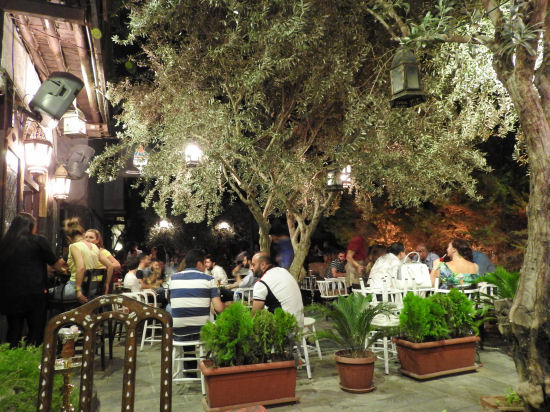
The Abu Zolouf bar is one among many bars and lounges opened in the East Gate quarter of the Old City in recent months. Two years ago, I sat with the adjacent restaurant owner, Nabil, outside his then-vacant restaurant discussing the frequent mortars that Jebhat al-Nusra and the Free Syrian Army were firing on Damascus, from Jobar, less than 1 km to the northeast. As mortars fell in nearby districts of the Old City, Nabil narrated close-calls he had had with such mortars hitting outside his restaurant. He also lamented the loss of customers in recent years. Since their May 30, 2016, opening, the Abu Zolouf bar has nightly from 70 to 150 patrons looking to relax outdoors.The Abu Zolouf bar is one among many bars and lounges opened in the East Gate quarter of the Old City in recent months. Two years ago, I sat with the adjacent restaurant owner, Nabil, outside his then-vacant restaurant discussing the frequent mortars that Jebhat al-Nusra and the Free Syrian Army were firing on Damascus, from Jobar, less than 1 km to the northeast. As mortars fell in nearby districts of the Old City, Nabil narrated close-calls he had had with such mortars hitting outside his restaurant. He also lamented the loss of customers in recent years. Since their May 30, 2016, opening, the Abu Zolouf bar has nightly from 70 to 150 patrons looking to relax outdoors.
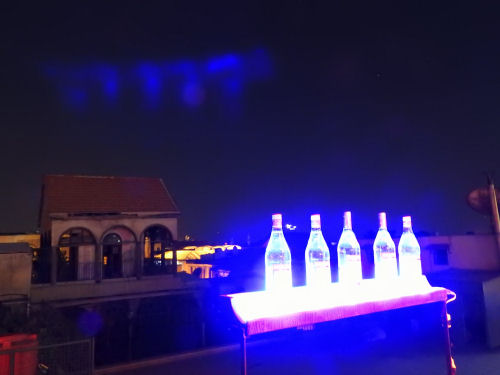
Le Visage, also in the East Gate quarter, was among the first outdoor establishment to open after the mortars stopped some months ago. From its rooftop position, one can look down on the historic Straight Street leading up to East Gate, as well as see life on balconies opposite, where months prior they were empty. A display of lighted alcohol bottles gleam in the dark, with Jobar less than 1 km beyond. A Damascus youth noted: “Imagine, ISIS are about 4 km away and we are opening new bars. This is the Syrian people.” Le Visage, also in the East Gate quarter, was among the first outdoor establishment to open after the mortars stopped some months ago. From its rooftop position, one can look down on the historic Straight Street leading up to East Gate, as well as see life on balconies opposite, where months prior they were empty. A display of lighted alcohol bottles gleam in the dark, with Jobar less than 1 km beyond. A Damascus youth noted: “Imagine, ISIS are about 4 km away and we are opening new bars. This is the Syrian people.”
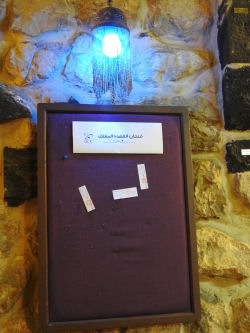
In an artsy restaurant along the Straight Street, stone walls are adorned with the owner's brighly-coloured paintings and a solitary board with the words “Cup of Coffee Pending” at the top. Hekmat Daoud, an artist and prominent costume designer, also the eccentric hospitable owner of Kasida Dimashqia restaurant, employs a tradition he says is common in Naples, Italy. “When paying for their bill, people can pay extra towards free drinks for students or those too poor to afford one.” After a thirsty weekend, only a few promises of coffee remain. “There were more before, but students came and wanted arak and beer,” Daoud laughed.In an artsy restaurant along the Straight Street, stone walls are adorned with the owner’s brighly-coloured paintings and a solitary board with the words “Cup of Coffee Pending” at the top. Hekmat Daoud, an artist and prominent costume designer, also the eccentric hospitable owner of Kasida Dimashqia restaurant, employs a tradition he says is common in Naples, Italy. “When paying for their bill, people can pay extra towards free drinks for students or those too poor to afford one.” After a thirsty weekend, only a few promises of coffee remain. “There were more before, but students came and wanted arak and beer,” Daoud laughed.
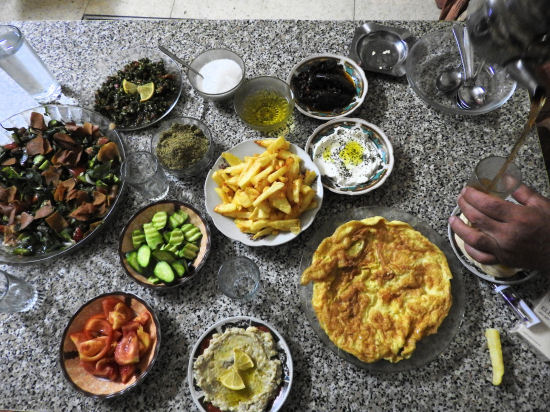
A shared meal with local family in the Old City. After over five years of the war on Syria, prices for all basic goods have risen dramatically, while incomes remain the same or shattered. The Western sanctions on the Syria worsen the situation, hurting the Syrian people and social services the most.A shared meal with local family in the Old City. After over five years of the war on Syria, prices for all basic goods have risen dramatically, while incomes remain the same or shattered. The Western sanctions on the Syria worsen the situation, hurting the Syrian people and social services the most.
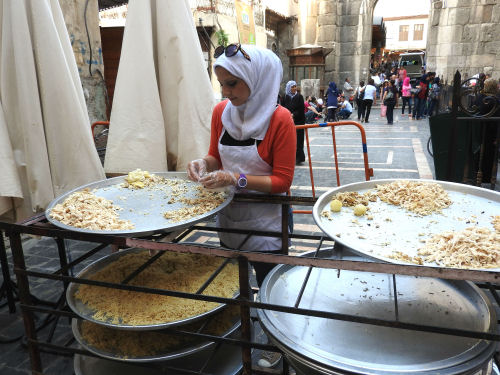
Behind the Umayyad Mosque in Old Damascus, one of tens of volunteers daily helps prepare the Iftar (fast-breaking) meals that the Saaed Association was serving to impoverished Damascus residents, even delivering to those unable to pick up meals themselves. Starting with 3,000 recipients, by the end of Ramadan, the volunteers were providing 10,000 meals daily in Damascus alone, with another combined 7,000 meals prepared in Hama and Homs. Behind the Umayyad Mosque in Old Damascus, one of tens of volunteers daily helps prepare the Iftar (fast-breaking) meals that the Saaed Association was serving to impoverished Damascus residents, even delivering to those unable to pick up meals themselves. Starting with 3,000 recipients, by the end of Ramadan, the volunteers were providing 10,000 meals daily in Damascus alone, with another combined 7,000 meals prepared in Hama and Homs.
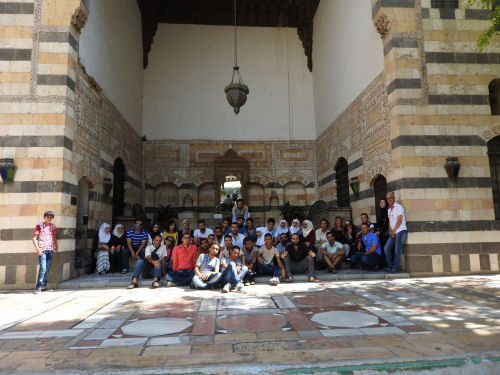
Volunteers from the Saaed Association relax after the second day of 'Eid activities for children. Instead of clothes or money, “we gave children hope and joy,” one volunteer said. In contrast to the sectarianism imposed on Syria by Gulf States and Turkey, Syrians maintain their unity and secularism, emphasized by such volunteers whose allegiance is to humanitarism and helping the less fortunate. Volunteers from the Saaed Association relax after the second day of ‘Eid activities for children. Instead of clothes or money, “we gave children hope and joy,” one volunteer said. In contrast to the sectarianism imposed on Syria by Gulf States and Turkey, Syrians maintain their unity and secularism, emphasized by such volunteers whose allegiance is to humanitarism and helping the less fortunate.
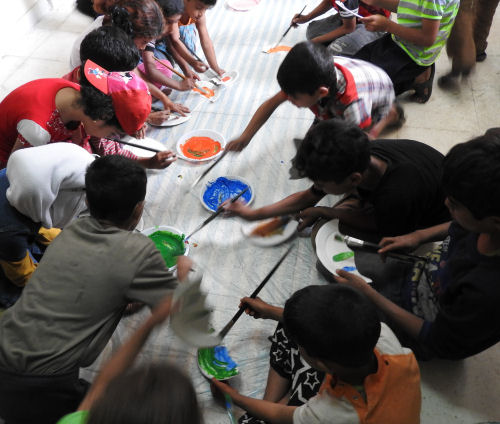
The phenomenon of children begging in the streets was not common in Syria prior to 2011. While some children work to help surpport their families who have been rendered destitute due to various effects of the war on Syria, according to Damascus locals, the majority of these children work in a sort of forced labour for ring-leaders coming from the eastern Ghouta region. Many associations work to provide basic services to these children. One such volunteer organization provides education and meals, teaching children not only the basics of reading and writing, but also works to instill moral values and give opportunities, however briefly in their work-day, for children to be children. The phenomenon of children begging in the streets was not common in Syria prior to 2011. While some children work to help surpport their families who have been rendered destitute due to various effects of the war on Syria, according to Damascus locals, the majority of these children work in a sort of forced labour for ring-leaders coming from the eastern Ghouta region. Many associations work to provide basic services to these children. One such volunteer organization provides education and meals, teaching children not only the basics of reading and writing, but also works to instill moral values and give opportunities, however briefly in their work-day, for children to be children.
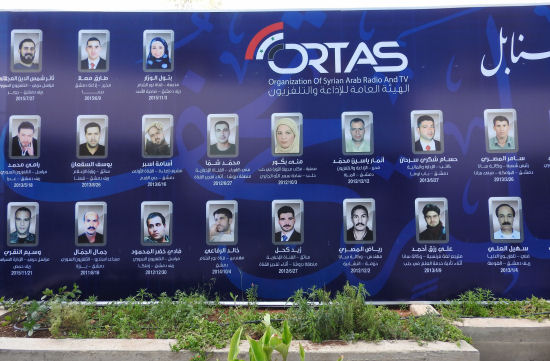
Statistics from the Syrian Ministry of Information (November 2015) cite as many as 50 “members of Syrian mass media establishments” killed while at work or reporting. Thaer Al-Ajlani, top left, was killed on July 27, 2015 when hit with shrapnel from a mortar fired by Jebhat al-Nusra, then occupying much of Jobar. Other martyred journalists have been killed by terrorists' sniper attacks, point-blank assassinations, shellings and gunfire while reporting. Corporate media and international associations to protect journalists have largely ignored the deaths of Syrian journalists killed by western-backed terrorist factions. Statistics from the Syrian Ministry of Information (November 2015) cite as many as 50 “members of Syrian mass media establishments” killed while at work or reporting. Thaer Al-Ajlani, top left, was killed on July 27, 2015 when hit with shrapnel from a mortar fired by Jebhat al-Nusra, then occupying much of Jobar. Other martyred journalists have been killed by terrorists’ sniper attacks, point-blank assassinations, shellings and gunfire while reporting. Corporate media and international associations to protect journalists have largely ignored the deaths of Syrian journalists killed by western-backed terrorist factions.
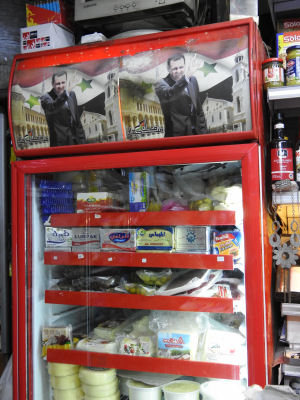
Stopping to buy water in an Old City shop, the owner's only issue with me taking a photograph of his fridge is that he wants to dust off the photos of President Assad a bit first, apologizing that they are old, from well-before the current crisis.Stopping to buy water in an Old City shop, the owner’s only issue with me taking a photograph of his fridge is that he wants to dust off the photos of President Assad a bit first, apologizing that they are old, from well-before the current crisis.
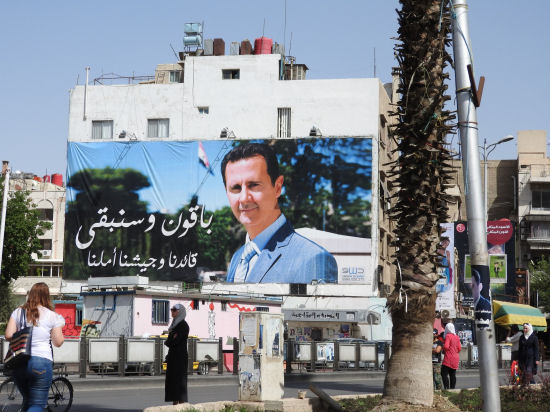
“We are here and will stay here. Our leader and our army is our hope.” The sign speaks the sentiment of Syrians I have met in Aleppo, Homs, Latakia, Sweida, Ma'loula, and Damascus. The popularity of President al-Assad has even been admitted by western sources in recent years as at least 70%, although popular sentiment on the streets would put the figure even higher.
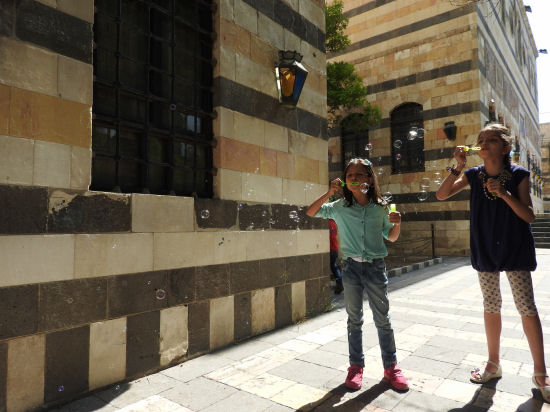
Children on the second day of 'Eid. Although Damascus is largely secure and safe, many living in the city are directly affected by the war on Syria, with many having lost a family member, been rendered financially-insecure, or been displaced from areas of the country. Children on the second day of ‘Eid. Although Damascus is largely secure and safe, many living in the city are directly affected by the war on Syria, with many having lost a family member, been rendered financially-insecure, or been displaced from areas of the country.
Recent comments